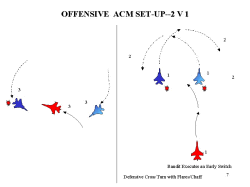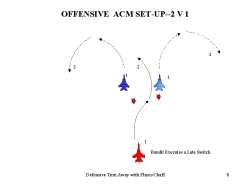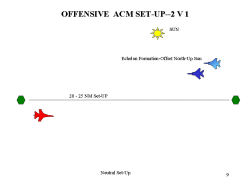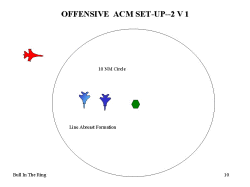| |

The cross turn is used to make the bandit choose a target and free up the other fighter. It may also help to confuse the bandit and make him hesitate on which target to attack. More importantly, it can place the untargeted fighter in a better offensive position quicker.
Finally, the turn away is just the opposite of the cross turn and is used to build even more separation and turning room for the un-targeted fighter. Typical defensive comm would sound like this:

Upon detection of attack call for a break.
Eagle 1: Eagles break left-bandit deep 6 attacking (flares and chaff automatic at the break call)
Execute the break into the bandit when able to cause an overshoot
Eagle 1: Eagle 1 is Tally single bandit left turn (altitude, speed, etc)-he 's on me
Eagle 2: Eagle 2 is tally-visual-engaged
Eagle 1: Eagle 1s bandit passing left continuing to turn through west
Eagle 2: Tally engaged-Fox 2-Kill-Off north
Eagle 1: Eagle 1 is visual-joined
It can be that quick!
TRNMSN 7-2v1 Neutral
This mission starts from a BVR (beyond visual range) set-up and concludes with a visual engagement using the entry maneuvers practiced in the previous missions. Start with an initial set-up of 20-25NM and at a pre-determined CAP (Combat Air Patrol) point. Altitude and speeds remain the same for the Initial CAP. Eagle 1 calls "ready" and "fights on" at which time the bandit is cleared down track. The element leaves the CAP once the target is detected and maneuvers for offset. The offset serves two purposes.

Click to continue
|
|
First it gives you maneuvering room to turn. Second, it takes you off the bandits radar search area or at least to the edge of it. A change in altitude is also advisable at this time.
When using the offset, strive to be higher than the bandit (potential energy) and offset so that the element is coming out of the sun during the attack. Do not, however, cross the bandits nose just to gain the up sun position. The bandit can maneuver once he has tally on the element passing his 3/9 line (wings) or the element calls a shot. From this point it is standard element maneuvering. Repeat as necessary until proficient and use different formations.
TRNMSN 8-1v2 Defensive ACM
This mission differs from the previous missions in that now the bandit will attack using different altitudes and coming from different cardinal directions. This mission is also known as the "bull in the ring."
Establish a CAP point in the area. The element must stay within 10NM of the point at all times. Element set-up is line abreast, 20-25,000 feet, and 450-475 knots.
At fights on, the element must defend itself from the single bandit using good visual lookout and short range radar work. The bandit can enter the fight from any altitude (not below the floor) and direction. Call a "terminate" after each attack to allow all players to set-up again. Repeat as necessary until all attacks are detected and your response is successful.
Once these training missions are complete, the training pilot is ready to proceed to 2v2 ACM, which will be covered in Part 3.

Bull in the Ring.
Fighting in the air is not a sport. It is scientific murder. Eddie Rickenbacker, "Fighting the flying Circus," 1919

Warren "Big Red" Hudson is a former USAF officer. During his 17 year career, he served as a fighter controller, instructor, evaluator, AWACS Mission Commander, and USAF Aggressor @ Nellis AFB.
Warren has over 200 hours of backseat fighter time in USAF/Canadian T-33, F-4, CF-18, F-15, F-5/AT-38, and F-16. Additionally, he has over 1000 hours as an E-3 AWACS Mission Commander and over 6,000 recorded tactical engagements as a fighter controller.
|
|